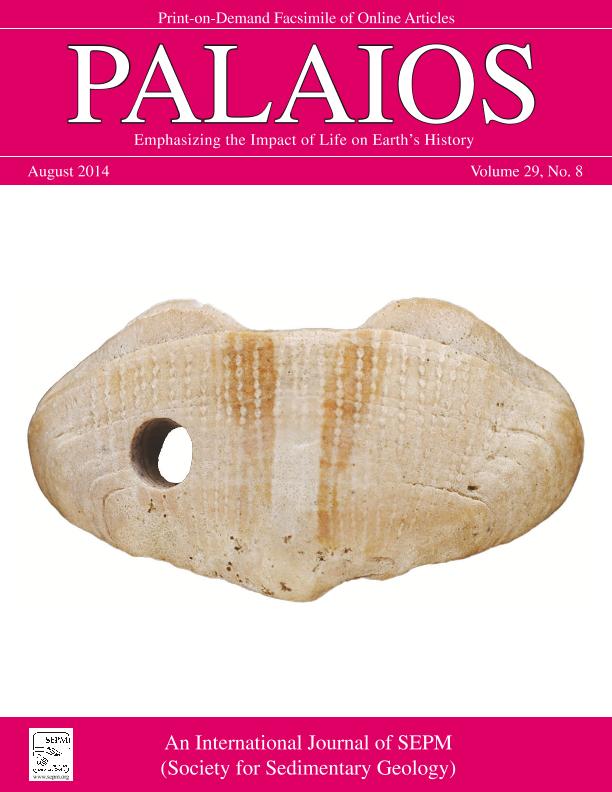Mostrar el registro sencillo del ítem
dc.contributor.author
Rojas, Alejandra

dc.contributor.author
Verde, Mariano

dc.contributor.author
Urteaga, Diego Gaston

dc.contributor.author
Scarabino, Fabrizio
dc.contributor.author
Martínez, Sergio
dc.date.available
2017-06-29T19:39:35Z
dc.date.issued
2014-08
dc.identifier.citation
Rojas, Alejandra; Verde, Mariano; Urteaga, Diego Gaston; Scarabino, Fabrizio; Martínez, Sergio; The first predatory drillhole on a fossil chiton plate: an occasional prey item or an erroneous attack?; Society for Sedimentary Geology; Palaios; 29; 8; 8-2014; 414-419
dc.identifier.issn
0883-1351
dc.identifier.uri
http://hdl.handle.net/11336/19192
dc.description.abstract
Drillholes represent direct evidence of ecological interactions in the fossil record. Most of them have been interpreted as predatory in origin and enable the analysis of behavioral information of both predator and prey. Drillholes have been found in a variety of fossil organisms, but this is the first report of a bored fossil chiton plate. It was found in the La Coronilla deposit, a Late Pleistocene invertebrate assemblage from southeastern Uruguay. The drillhole belongs to the ichnospecies Oichnus simplex and is attributed to a muricid gastropod, which could likely have been the ocenebrinid Urosalpinx haneti, recorded in the fossil assemblage. The drillhole features all traits for a predatory origin. However, the rareness of this particular interaction between chitons and gastropods in the fossil record and in the recent, could signify an event of arbitrary drilling. The reported occurrence here raises the question as to whether this behavior represents an understudied ecological interaction between polyplacophorans and gastropods.
dc.format
application/pdf
dc.language.iso
eng
dc.publisher
Society for Sedimentary Geology

dc.rights
info:eu-repo/semantics/openAccess
dc.rights.uri
https://creativecommons.org/licenses/by-nc-sa/2.5/ar/
dc.subject
Paleoecology
dc.subject
Oichnus Simplex
dc.subject
Polyplacophora
dc.subject
Pleistocene
dc.subject.classification
Oceanografía, Hidrología, Recursos Hídricos

dc.subject.classification
Ciencias de la Tierra y relacionadas con el Medio Ambiente

dc.subject.classification
CIENCIAS NATURALES Y EXACTAS

dc.subject.classification
Paleontología

dc.subject.classification
Ciencias de la Tierra y relacionadas con el Medio Ambiente

dc.subject.classification
CIENCIAS NATURALES Y EXACTAS

dc.subject.classification
Biología Marina, Limnología

dc.subject.classification
Ciencias Biológicas

dc.subject.classification
CIENCIAS NATURALES Y EXACTAS

dc.title
The first predatory drillhole on a fossil chiton plate: an occasional prey item or an erroneous attack?
dc.type
info:eu-repo/semantics/article
dc.type
info:ar-repo/semantics/artículo
dc.type
info:eu-repo/semantics/publishedVersion
dc.date.updated
2017-06-28T19:41:45Z
dc.journal.volume
29
dc.journal.number
8
dc.journal.pagination
414-419
dc.journal.pais
Estados Unidos

dc.description.fil
Fil: Rojas, Alejandra. Universidad de la República. Facultad de Ciencias; Uruguay
dc.description.fil
Fil: Verde, Mariano. Universidad de la República. Facultad de Ciencias; Uruguay
dc.description.fil
Fil: Urteaga, Diego Gaston. Consejo Nacional de Investigaciones Científicas y Técnicas. Oficina de Coordinación Administrativa Parque Centenario. Museo Argentino de Ciencias Naturales "Bernardino Rivadavia"; Argentina
dc.description.fil
Fil: Scarabino, Fabrizio. Ministerio de Ganadería, Agricultura y Pesca; Uruguay
dc.description.fil
Fil: Martínez, Sergio. Universidad de la República. Facultad de Ciencias; Uruguay
dc.journal.title
Palaios

dc.relation.alternativeid
info:eu-repo/semantics/altIdentifier/doi/http://dx.doi.org/10.2110/palo.2014.030
dc.relation.alternativeid
info:eu-repo/semantics/altIdentifier/url/http://palaios.geoscienceworld.org/content/29/8/414
Archivos asociados
